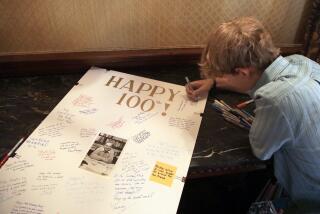Time Slips Through the Glass, but Caltech Artisan’s Dedication Remains Undimmed
- Share via
When he was a little boy in Ilmenau, Germany, Erich Siegel heated glass to its melting point for an uncle who blew the molten globs into fascinating shapes. Although Siegel was not aware of it then, his future was right there in his hands, taking on its own fascinating shape.
In effect, Siegel never let go of the glass tubing and rods that earned him “10 pennies an hour” when he was 10 years old. He began studying and working in earnest at 15 and eventually earned a master’s degree in glass blowing and instrument technology. He came to the United States 35 years ago after his homeland had been ravaged by war and poverty.
Now Siegel is 70 and still an artisan in an ancient and vanishing craft.
There is nobody like him, according to scientists at Caltech, where for 26 years Siegel has created intricate apparatus for scientific projects.
“Erich has helped out on very difficult projects and made numerous contributions to chemistry,” said Harry Gray, former chairman of Caltech’s chemistry department. “But what really makes him unique is that certain style and personality. It’s his pride of workmanship that makes him special.”
Although he retired more than a year ago, Siegel’s expertise is still so in demand that he works a 48-hour week.
In a huge but obscure laboratory behind an unmarked door in Caltech’s Noyes Chemistry Building, Siegel still oversees the production of thousands of glass instruments, valves, tubes and bulbs that must be made to order according to scientists’ exacting measurements. Two other glass workers, one of whom learned the art from Siegel, work full time.
In a vigorous run-through of his workplace, Siegel displayed a transparent mercury diffusion pump, oil pumps with glass spirals and bulbs encased in glass tubing, a 10-foot-long chemist’s vacuum line with hundreds of hand-made glass gadgets, cupboards with hundreds of sizes and varieties of glass tubing, ovens and flames that heat to more than 1,000 degrees centigrade, and assorted instruments and tools everywhere.
“Look, it comes windows on it, and comes liquid through,” said Siegel in English that is still fashioned by his native tongue, as he exhibited an elaborate hand-blown laser apparatus with windows and holes.
Longevity appears to be part of every commitment Siegel has ever made.
“I’m 55 years in my life’s work,” Siegel said. “I’m 40 years married, 35 years in America and 26 years at Caltech. No one has as many years of experience--that’s why I’m still here,” he said.
In Ilmenau, Siegel said, “every second house is a glass shop, because of the sand there.” His father worked in decorative porcelain, his uncle had a glass shop, and young men such as he went to the School of Glass Instrument Technique. While still in Germany, he said, he had a hand in making the first electron microscope. His skills require an understanding of chemistry, engineering and whatever other science is involved in the instruments he makes.
In his spare time, Siegel said, he makes candelabra, figurines and vases for his home. Occasionally, he said, top Caltech officials ask him to make special gifts for visiting dignitaries.
“Oh, this is good,” Siegel said, describing his life with his wife, Gerda, and their many German friends.
He was asked if he ever thought of doing any other kind of work.
“What do you mean?” he asked.
Well, did he ever tire of 55 years in the same field?
“I don’t understand,” he said. “That just couldn’t happen. No. Of course not.”
More to Read
Inside the business of entertainment
The Wide Shot brings you news, analysis and insights on everything from streaming wars to production — and what it all means for the future.
You may occasionally receive promotional content from the Los Angeles Times.










